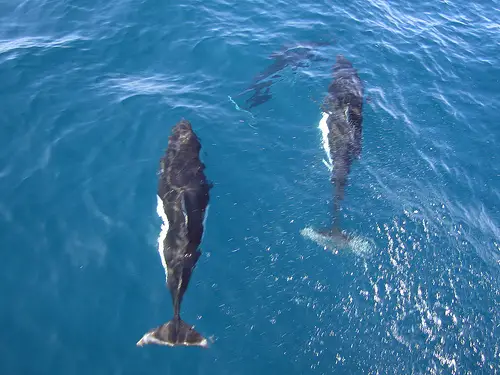Humpback Whale
Some say the humpback whale is fifty feet long, others that it is more like sixty-five feet long. Either one is a pretty impressive length. Their flippers are very large also, from three feet wide to possibly 16 feet long.

Humpback Whale Diving
That is a nice size flipper for the female whale to protectively hold above her calf who is a whopping twelve feet long when it is born. Past knowledge claimed that a humpback could only produce a calf every two or three years.
Now scientists have seen an identified whale which had a new calf each year for several years, and nearly twenty percent of the other females in the studied group did also.
The whales are identified by the distinctive patterns of black and white pigments on the underside of their tail flukes.
They are highly mobile mammals, traveling to Hawaii to breed in the winter and in April they are traveling again — going at a stately 3.5 mph an hour as they head for feeding grounds in Canada and then sometimes all the way to Kamchatka. There are whales in the Northern Hemisphere and in the Southern Hemisphere.

Humpback Whale
They tend to prefer coastal areas, possibly a link to their long ago ancestors who moved on four legs and lived out of the water some of the time.
Being in the coastal areas makes them more susceptible to pollution.
The humpback is a type of whale called a baleen whale. They have a way to take water into the mouth and when closed, the water comes out passing through the fringed borders of the baleen or whalebone and the tiny shrimp, called krill are kept in their mouth.
The humpback whale, while a more bulky shape that other baleen whales, is very agile and loves to leap out of the water and fling those long flippers out wide — almost as though they were going to fly away. They seem to love making a big splash when they hit the water.

Humpback Whale
During breeding time seems to be when whales do the most singing. The males do the singing and they do complex songs — some lasting up to thirty minutes. The whales in the same region all sing the same song.
Experts on whales have recorded these musical exhuberations which reverberate through the water, and they analyze them, looking for answers to the mysteries of the sea.
Besides the singing, when the humpbacks emit air from their blowholes they produce a sound like a siren.
The humpback whales are a very individualistic mammal and impart certain grandeur to our seas. They are interesting to study and people are becoming aware of the need to protect them.

Humback Whale Fin
Their numbers have been increasing which is definitely good news for them and for us.
Find out more about the Humpback Whale over at Wikipedia »



thank you ,
Please send me another type of picture on ” Secondery Aquatic Adaptation on Whale.”
these are looking very cute and beautiful pictures